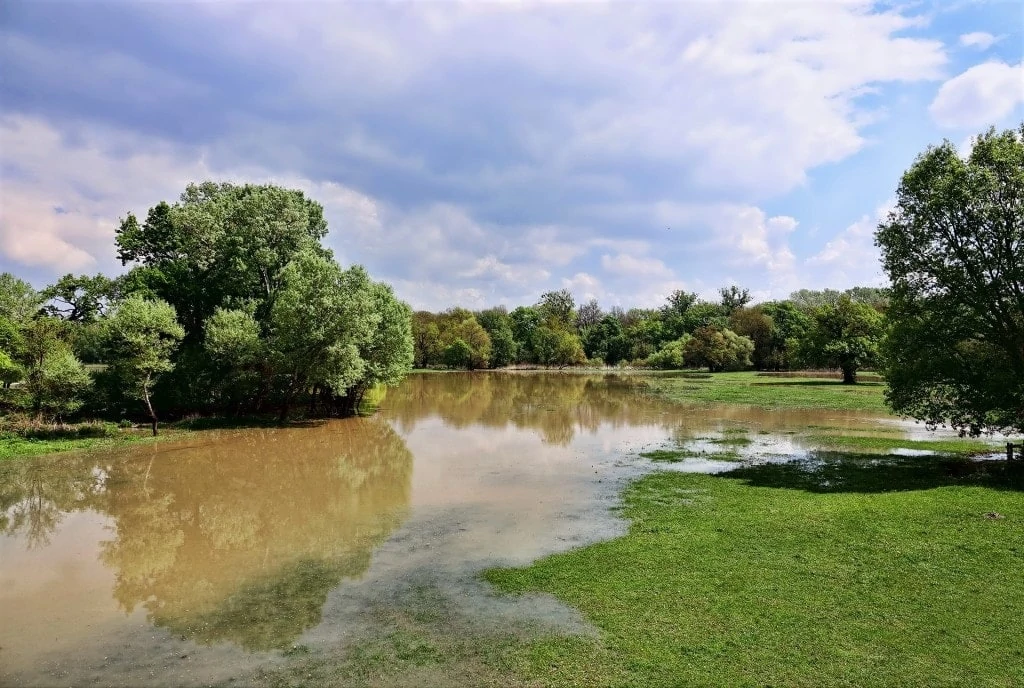by Amanda Rose Newton
Florida boasts a unique geology that provides many coastal areas with sandy, well-draining soil, but also creates low-lying patches where water naturally accumulates. Brevard County is no exception, and with the rainy season on the horizon, many may think those slow-to-drain spots are doomed to be empty and boring all summer long. Surprisingly, there are plants that flourish in soggy conditions and many even have color to offer. Below, we give you our top ten choices for plants with “wet feet”, to borrow a horticulture term, covering everything from groundcovers to trees.

Asiatic Jasmine (Trachelospermum asiaticum) is one of the easiest plants to care for that we sell. This groundcover is unique in that it can handle shade as well as the occasional drought. Beyond that, it comes in a variety of colors, from the simple light stripes of the variegated variety to the deep hues of red, yellow, and orange in the tri-color. With a 3 ft wide spread and 2 ft height, it provides ample coverage with added texture and color.
For a taller choice, the African iris (Dietes spp.), with its exotic white or purple blooms, thrives in wet conditions. In addition to withstanding wet conditions, it easily puts up with drought and requires little maintenance. At 2-3 ft tall, it makes a lovely low hedge or border.
Canna lilies (Canna indica) infuse an otherwise entirely green landscape with bright color. They also feature tropical foliage and pack some height. As long as they receive full sun, they will be happy even in a water-retaining spot.
With its orange and red blooms, impressive height and spread, the native Firebush (Hamelia patens) is a wonderful choice for a lower-lying area. Attracting both hummingbirds and butterflies, it adds more than just beauty to the landscape.
Wax Myrtle (Myrica spp), another Florida native, is another low maintenance plant for almost any yard. In addition to providing shade and food for wildlife, it is virtually carefree once established. At 12-20 ft tall, it doubles as a handy screen. (see our video about Wax Myrtles here)
Bald cypress (Taxodium distichum) is the classic lowland loving tree. With its unique bark and characteristic knobbing knees, it is perhaps the easiest way to add distinct character to your yard.
Red bay (Persea borbonia), a slightly smaller tree, stays evergreen and features denser foliage. Its aromatic scent and beautiful wood make it an interesting, attractive addition to your landscape.
If you cannot imagine a Florida yard without a palm tree, consider Florida’s own Cabbage Palm (Sabal palmetto). Native works to its advantage, as it thrives in most statewide conditions and adds a tropical flare to the landscape.
Looking for something a little more unique? Wamin ( Bambusa vulgaris ‘Wamin’) or Buddha Belly bamboo doubles as an elegant screen. Growing centrically, this clumping bamboo maxes out at 15 ft.- much smaller than most bamboo varieties, making this look obtainable to most homeowners.
Growing your own fruit does not need to be out of the question just because you have a few water-loving spots in your landscape. The Java plum (Syzygium cumini) is a smaller shrub that loves moisture. It also happens to produce delicious small, oblong fruits that have a taste reminiscent of plums and berries.
This is just a sampling of the wide variety of plants that will happily make themselves at home in those wet areas in your yard. Consult our wet areas information sheet, and our friendly staff is always willing to give advice and offer suggestions.


